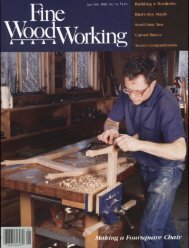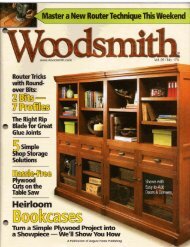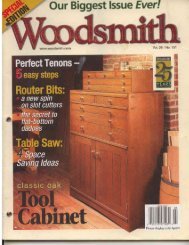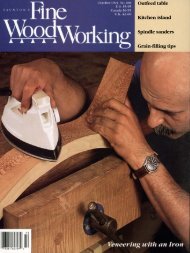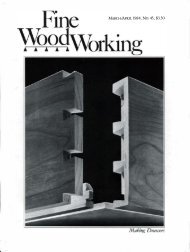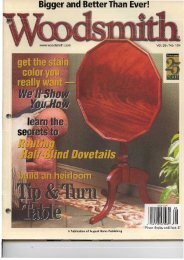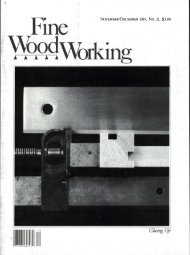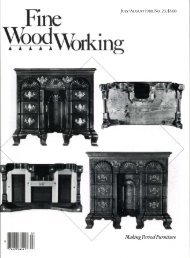Shaping with a Router - MetosExpo - Free
Shaping with a Router - MetosExpo - Free
Shaping with a Router - MetosExpo - Free
You also want an ePaper? Increase the reach of your titles
YUMPU automatically turns print PDFs into web optimized ePapers that Google loves.
Editor's Notebook<br />
Mastering the scraper-The articles by E.S. Martin and Pat Buford<br />
about sharpening scrapers in FWW #91 elicited quite a response.<br />
I suspected we would get some mail on this subject because<br />
I knew that most woodworkers share the same kind of<br />
frustration <strong>with</strong> sharpening a scraper that Martin and Buford<br />
described in their articles.<br />
When I was introduced to a cabinet scraper by my first shop<br />
partner, Eddie Gnaedinger, back in the early 1970s, I was<br />
amazed that I'd never encountered this basic woodworking tool<br />
before. I figured that sandpaper manufacturers must have conspired<br />
to keep this handy device a secret for fear that it would<br />
drastically reduce sales of their products.<br />
For months, I continued to find new uses for my scraper and<br />
raved that it was the most used tool in the shop. But despite my<br />
vigorous testimonials, I managed to avoid learning how to sharpen<br />
it. Like Martin and Buford, I tried but never had much luck.<br />
Instead, I kept an eye on Eddie, and whenever I saw him sharpening<br />
his scraper, I'd mosey over and suggest that, in the interest<br />
of efficiency, he might as well sharpen mine too.<br />
Eventually I learned to prepare the edge and turn a burr on a<br />
scraper that would roll up a thin shaving and remain sharp for a<br />
reasonable period of time. And later, I found myself assuming<br />
the role of the designated scraper sharpener for other shopmates<br />
who were just being inu-oduced to this wonderful little workhorse.<br />
Although I haven't entirely abandoned my sandpaper-manufacturer-conspiracy<br />
theOlY, I've come to appreciate the fact that<br />
scraper knowledge isn't general knowledge but is instead passed<br />
from woodworker to woodworker-a kind of rite-of-passage into<br />
the secret society of woodworking. Here are three letters in response<br />
to Martin's article from readers offering their perspectives<br />
on sharpening a scraper. -Jim Boesel is executive editol- of FWW<br />
<strong>Free</strong> at last-I was pleased and relieved to see the article on<br />
sharpening scrapers in FWW #91. For years, I've been filing a<br />
flat (90°) edge on my scrapers and not raising a burr because it<br />
never seemed to work velY well when I tried it. The scrapers seem<br />
to work wonderfully <strong>with</strong>out a burr, but I've always looked over<br />
my shoulder (figuratively speaking) because I felt guilty about not<br />
doing something I thought I really should be doing. I'm going to<br />
continue not making a burr, but I won't feel guilty anymore.<br />
-Abijab Reed, Newton Centre, Mass.<br />
Using the right scraper for the job-I read <strong>with</strong> interest the<br />
article on sharpening scrapers in the December issue of FWW It<br />
struck home because I have been using file-sharpened cabinet<br />
scrapers for quite a while now. And just like the author, frustration<br />
<strong>with</strong> getting and holding a good burr using the traditional<br />
techniques led me to this simple method.<br />
However, there were two minor flaws in the text. First, it<br />
should have been pointed out that a filed scraper edge can never<br />
leave the same kind of surface on wood as one that has been<br />
filed, honed and burnished. Many craftsmen scrape their surfaces<br />
to perfection in preparation for finishing instead of using<br />
sandpaper. When the light strikes d1e surface of these finished<br />
pieces, the wood comes to life. You know you are looking at a<br />
surface that sandpaper has not touched. Such a surface cannot<br />
be achieved <strong>with</strong> a filed scraper because d1e marks left by the<br />
file on the scraper's edge will be u-ansferred to d1e wood. A filed<br />
scraper should be viewed as a preliminalY way of dressing down<br />
a surface speedily and efficiendy. Then you should eid1er expect<br />
to do some sanding or you should give your project a few strokes<br />
<strong>with</strong> a properly burnished scraper to bring it to perfection.<br />
The second flaw was in d1e suggestion d1at a single scraper be<br />
used both for fine finishing and glue scraping. You should have<br />
separate scrapers for various tasks: a thick one for glue, a filesharpened<br />
one for rough work on wood and a burnished one<br />
for fine work. Over d1e years I've acquired a collection of scrapers<br />
of various sizes, thicknesses and qualities of steel. Because I've become<br />
aware of the subdeties of ead1, there will always be one<br />
scraper that has just the characteristics I need for a particular job.<br />
-Thomas Wissback, Galesburg, Ill.<br />
A fool-proof method?-My method for sharpening a scraper<br />
takes some of the guesswork out of the process. The secret is a<br />
2-i 1.-thick-maple block about 12-in.-sq. <strong>with</strong> one end cut clean<br />
and square and sanded smooth. I use this end as a regisu-ation<br />
surface when filing, honing and burnishing d1e scraper's edge.<br />
Begin by clamping the block to a workbench or table. Lay d1e<br />
scraper flat on top of the block and press a fine file against<br />
d1e block's smoothed end. Now, press the scraper lighdy against<br />
d1e file; swing d1e file back and ford1 a few times to remove d1e old<br />
burr or any nicks and to square d1e scraper's edge. Repeat this on<br />
each edge of the scraper, and d1en do the same <strong>with</strong> a coarse stone<br />
followed by a fine stone. A drop or two of oil on the scraper will<br />
lubricate the stones and will also help when you get to the burnishing<br />
phase. ext, lay the coarse stone flat on the scraper and<br />
rub a bit on both sides to remove any burr d1at you've created.<br />
Finish <strong>with</strong> a fine stone against the end of the block again.<br />
At d1is pOint, you can feel that the edge is square and d1e corners<br />
are very sharp. Now, while pressing the scraper down on<br />
the block, hold a burnisher at about a 5° angle, and take a few<br />
light su-okes on the scraper's top edge. Run your knuckles along<br />
the end of d1e block to help maintain the slight angle; I usually<br />
let the scraper overhang the end of the block a bit while burnishing<br />
and adjust the overhang to help set the correct angle.<br />
I can put a good edge on a scraper in about four minutes,<br />
including taking out d1e equipment and putting it away again.<br />
The block gives the correct angle so there is no need for great<br />
care. And the swinging motion of d1e stone means there is no<br />
tendency to wear a groove in it. -David Gather, Los Angetes, Cal.<br />
UNTON<br />
PUBUCXfIONS<br />
... by fellaw enlhusillSlS<br />
The Taunton Press: Paul Roman,presitielltiJanice A. Roman, vice<br />
preSident; Carolyn Kovaleski, administrative secretary. Corporate<br />
Staff Directors: Susan Edelman, deSign; John Kelsey, editorial; john<br />
Lively, cbie! Of staff; jan Wahlin, marketing. Accounting: \Vayne<br />
Reynolds, control/c.".., Patrick Lamontagne, manager; jeffrey Shenn:Ul,<br />
Susan<br />
financial analyst; Mary Sullivan, general ledger superViSor; Carolyn<br />
Stiles,jr. cast accountant; Carol Diehm, accounts payable supervisor;<br />
Burke, accounts payable clerk; uwrence Rice, credit supervisor;<br />
Lyctia Krikorian, senior collection clerk; Judith Rivera, Victoria<br />
Theobald, collections clerks; Diana D'Onofrio, payroll coordinator;<br />
Andrea DuBois. Elaine Yamin, junior accountants; Dorothy Blasko,<br />
secretary. Corporate Design: Philip Allard, promotion services coordinator<br />
books/videos; Steven Hunter, art director, Thomas Baker, promotion<br />
services coordinator magazines; Wendy Bowes,judy Lind, associate<br />
tlrt directors; Mary Beth Cleary, promotion production<br />
roordbudor, Franc esca Arminio, promotion asst. Art Production, Robert<br />
Olah, mal101:,lf!r'; Henry Roth, Catherine Cassidy, associate art directors;<br />
Jodie DeJohery, assista11l art director; tLiana Koehler, production. ,mis·<br />
tanto Copy/Production: RUlh Dobsevage, managing editor; Peter<br />
Chapman, Pamela Purrone, COPY/production editors. Corporate<br />
Sales: lY.t1e Brown, director; Donna Pierpont, publiC relations manager;<br />
Diane i>'ducrson, executive secretary; Andrea Ondak, trat/e and<br />
special sales mQlUlger, Barbara Buckalew, marketing assistant; Marcie<br />
Siegel, publicity/trade sales asst.; Lori MOir, telemarketer. Data Pro·<br />
cessing: Drew Salisbury, manager, Brendan Bowe,Julftllment systems<br />
manager'; Roger Seliga, scniorprogrammerlanalyst; Gabriel Dunn, programmer/analyst;<br />
Arthur Caron, Roben Nielsen, programmers; james<br />
Kinnear, tech. services admin. Sherill Kolakowski, computer support<br />
tecbnician. Folkwcar: Cheryl Clark, mgr.j Garol Ge, ((t/mill. asst.;<br />
Gregory McMahan, pattern designer. Fulfillment & Operations:<br />
Tom Luxeder, director; Jane Torrence. secretary. Client Services:<br />
Patricia Williamson, coordinator, Roxanne Frimmel, Megan Sangster,<br />
client services representatives; Customer Service (subscriber):<br />
Patricia Malouff, manager; Nancy Schoch, senior customer service<br />
rep; Donna Weinstein, Diane Hurvul, Marylou 111Ompson. Mail Processing:<br />
Joyce Mc\ViUiam, supervisor; Gayle Hammond, Barbara<br />
Lowe. Customer SenJice (trat/e): Christine Cosacchi, supervisor;<br />
Kristen Boeckmann, cust. service rep.; Gloria Carson, Peggy leBlanc,<br />
Denise Pascal, data ent,y. Distribution: Paul Seipold, manager;<br />
Grace AumuUcr, David Blasko, Michael Capalbo, James Chappuis,<br />
Mary Ann Costagliola, Maureen Aynn, Fred Monnes, Alice Saxton,<br />
Astor Taylor, Robert Weinstein; Linnea Ingram, secretary. Purcbasing<br />
& Facilities: William Schappen, manager; Lois Beck, Office services supervisor;<br />
john Zor, mail services; Chuck HoUis, maintenance foreman;<br />
Mark Cole, maintenance assistant; Christopher Myers,<br />
Donna<br />
buyer;<br />
<strong>Free</strong>man, cbeflm allager; Kathleen CosteUo, Nonna-jean Taylor,<br />
assistants. Subscnption: Carole Ando, managc.j Connie Barczak,<br />
Bonnie Beardsley, Brigitte Blais, Madelaine Frengs, Marie Paw,<br />
AndrC'd. Shorrock. Manufacturing: Kathleen Davis, director. Prepress:<br />
Austin E. Starbird, manager; Robert Marsala, grapbic arts supervisor;<br />
Susan Kahn, staff photographer; Nancy Atkinson, Chansam<br />
Thammavongsa, production assistants; Deborah Cooper, color center<br />
sUpe1visorj Richard Booth, nigbt-shijt supervisor; Mark Coleman,<br />
William Godfrey, Laurene jakab, color system operators; Nancy<br />
Knapp, composition production coordinator; Margot Knorr,publications<br />
applications manager; Monica Murphy, desktop publications<br />
associate; lisa DeFeo, system operator. Print Production: Diane<br />
Flanagan, manager (promo); 1110mas Greco, manager (books);<br />
Rosemary Pagel, associate (books); Philip VanKirk, manager- Onagazilles);<br />
Deborah Baldwin, assOCiate (magazines); Tracie Pavlik, sec·<br />
retary. Personnel: Carol Marotti, managerj Linda Ballerini, Chris<br />
Lincoln, personnel assistants. Video: Craif Umanoff, vitlc."O coorclinat01<br />
1110 mas Menard, asst. video producer.<br />
4 Fine Woodworking



